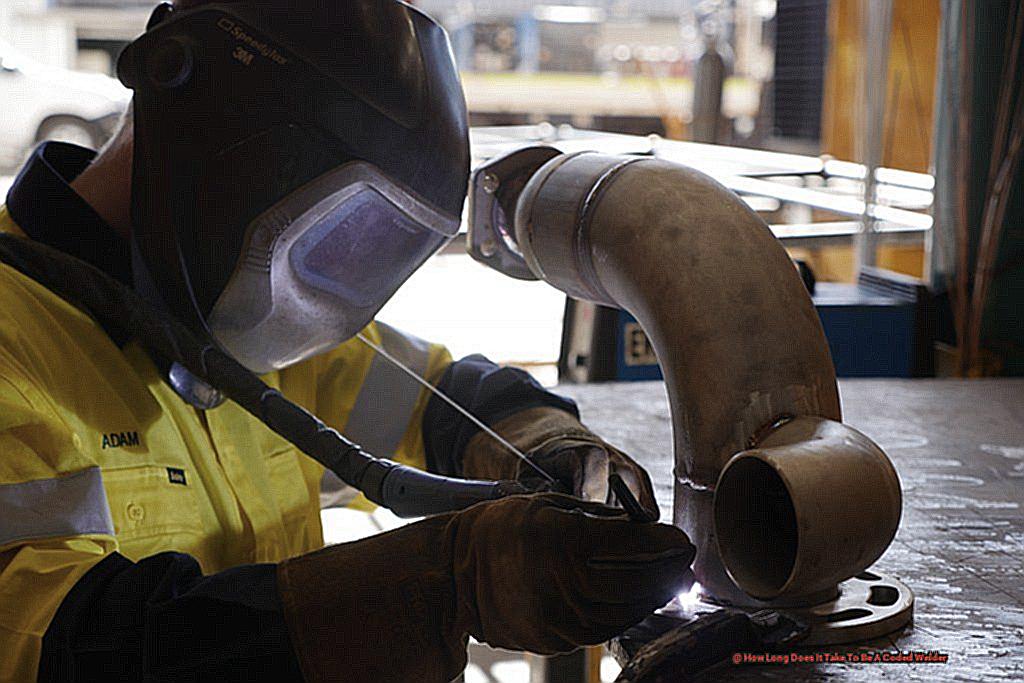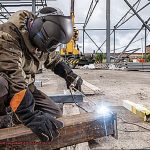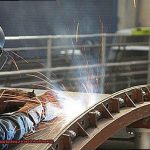Are you dreaming of a career as a coded welder?
Contents
- 1 Welding Certifications You Need to Know About
- 2 Obtaining a Welding License: What You Should Know
- 3 How Long Does It Take to Become a Certified Welder
- 4 How Much Does It Cost to Get Your Welding Certification
- 5 Welding Education Requirements
- 6 Enroll in Welder 101 and Get Your Career Started.
- 7 Conclusion
The thought of creating strong and durable structures with your own hands is undoubtedly exciting. But before you can start welding, you may be wondering: how long does it take to become a coded welder?
Well, the answer isn’t as simple as counting the number of hours spent in training. Becoming a skilled and certified coded welder requires more than just time – it takes dedication, hard work, and a passion for the craft.
In this blog post, we’ll delve into the details of what it truly takes to become a coded welder and how long it typically takes to reach that level of expertise. From education and training to gaining on-the-job experience, we’ll explore the journey towards becoming a proficient and sought-after coded welder.
So put on your welding gear and let’s get started.
Welding Certifications You Need to Know About
The art of welding requires a combination of precision, technique, and safety knowledge. As a skilled welder, you are well aware of the importance of certifications in advancing your career. These certifications not only showcase your expertise but also open up new job opportunities in various industries such as oil and gas, boiler and vessel work. In this post, we will delve into the world of welding certifications and their significance in enhancing your professional qualifications.
Certified Welder (CW): The Gold Standard
The Certified Welder (CW) certification, offered by the Canadian Welding Bureau (CWB), is a must-have for all welders working for a certified company. This certification ensures that you are up-to-date with industry standards and regulations. Recertification is mandatory every two years, making it crucial for welders to continuously hone their skills and knowledge.
Welding Inspector Certification: The Watchful Eye

The American Welding Society (AWS) offers the Welding Inspector Certification, which validates your proficiency in visual inspection theory and application for welded assemblies. This certification plays a pivotal role in maintaining quality control and ensuring safety in welding projects.
Red Seal Welder: The Key to National Recognition
The Red Seal Welder certification is an interprovincial qualification that allows you to work across Canada without any additional provincial requirements. It is highly esteemed and demonstrates your expertise in various welding techniques.
API Certification: For the Oil and Gas Industry
For welders seeking employment in the oil and gas industry, the American Petroleum Institute (API) offers specialized certifications for specific codes applicable to this field. This certification guarantees that you are qualified to perform designated welding procedures within the industry.
Obtaining a Welding License: What You Should Know
Wielding the power to transform raw materials into functional and aesthetically pleasing structures is a true art form. As a welder, you possess this unique ability; however, to elevate your welding career to new heights, you must possess more than just innate talent – you need certifications.
Becoming a coded welder is a daunting task that requires a fusion of knowledge, training, and hands-on experience. The first step towards achieving this esteemed title is to complete a formal education program. Whether it be a certificate or degree program from technical schools, community colleges, or vocational training centers, these programs lay the groundwork for mastering welding techniques, safety protocols, and blueprint comprehension.
But education alone is not enough. To truly master the craft of welding, you must ignite your skills through an apprenticeship or on-the-job training. This is where you will meld your theoretical knowledge with practical application in a real-world setting under the guidance of experienced welders. Typically lasting between 3-4 years, apprenticeships are offered by employers or unions.
Along with education and hands-on experience, obtaining a welding certification is the key to unlocking the coded welder title. The American Welding Society (AWS) offers various certifications for different welding processes such as shielded metal arc welding (SMAW), gas tungsten arc welding (GTAW), and gas metal arc welding (GMAW). To achieve these certifications, candidates must pass both written and practical exams to showcase their proficiency in their chosen welding process.
The timeline for becoming a certified coded welder varies depending on several factors such as the type of education program completed, the length of the apprenticeship, and the time taken to pass the certification exam. On average, it can take between 2-5 years to acquire full certification as a coded welder.
How Long Does It Take to Become a Certified Welder
The conundrum of how long it takes to become a certified welder is a puzzling one indeed. As an inquisitive individual with a keen interest in the world of welding, you may find yourself pondering over the timeline for achieving this esteemed certification. Alas, the answer is not a straightforward one, as it is largely dependent on various factors such as your chosen program and personal experience level. On average, it may take around 6-8 months to become a certified welder. However, do not be misled by this average, as there are several elements that can impact the length of your certification process.
First and foremost, the program and training style you select play a pivotal role in determining the duration of your welding certification. With welding schools offering both day and night classes, individuals have the flexibility to choose a schedule that aligns with their lifestyle. The frequency and intensity of your training can significantly affect the time it takes for you to become certified.
Moreover, your personal experience level is another crucial aspect to consider. If you have prior experience in welding, you may have an advantage over someone starting from scratch. This is because you may have already acquired some of the essential skills and techniques required for welding, which can help expedite your progress through the program.
It is also vital to note that there are different levels of welding certification, each with its own set of prerequisites and training. These levels include entry-level, advanced, and specialized certifications. Your chosen level will undoubtedly impact the length of your certification process, as each level demands a different amount of training and experience.
Furthermore, to become a certified welder, one must successfully pass both practical and written exams. These tests are designed to evaluate your knowledge and skills in various welding techniques and processes. The time it takes to prepare for and take these exams can vary depending on your ability to grasp the concepts taught in your program.
Lastly, practice and experience play a significant role in the length of your certification process.
How Much Does It Cost to Get Your Welding Certification
Welding is a highly coveted and in-demand skill in today’s competitive job market. With opportunities spanning across multiple industries such as construction, manufacturing, and shipbuilding, it’s no surprise that many are eager to become certified welders. But what does it truly take to become a certified welder and what are the associated costs? In this blog post, we will delve into the intricate levels of training and education available for aspiring welders, while also exploring the potential expenses involved.
Entry-Level Positions and Apprenticeships
For those embarking on their welding journey, entry-level positions serve as an ideal means to gain hands-on experience while simultaneously learning on the job. These positions typically require a high school diploma or equivalent and often provide on-the-job training. However, if one desires to advance their career and command a higher salary, obtaining a welding certification is crucial.
Apprenticeships are another sought-after option for aspiring welders seeking practical experience alongside formal training. These programs can last anywhere from 3-5 years and involve a combination of classroom instruction and hands-on training. The cost of apprenticeships can range from $0 to $1,300 depending on the program and location.
Training Courses and Degree Programs
For those partial to a more structured approach to learning, various training courses and degree programs are available for aspiring welders. These programs cover topics ranging from welding fundamentals and safety procedures to metal fabrication. The duration of these programs can vary from two years for a certificate to four years for a bachelor’s degree.
The cost of these programs can range from $5,000 to $15,000 at community colleges or technical schools. While associate’s degrees may cost less than bachelor’s degrees, they may not offer the same level of advancement opportunities in the long run. Bachelor’s degree programs delve deeper into topics such as metallurgy, engineering, and welding computer programming.
Welding Education Requirements
As an expert on the perplexing topic of Welding Education Requirements, I have compiled all the necessary steps for you to follow in order to become a skilled and certified welder.
Age and Education Prerequisites:
First and foremost, you must meet the age requirement of at least 18 years old to embark on your journey towards becoming a certified welder. Additionally, possessing a high school diploma or equivalent is a fundamental requirement for entering an accredited welding program or course.
Welding Course or Program:
Attending an accredited welding course or program is crucial in obtaining the necessary knowledge and skills for welding. These courses cover various welding techniques, safety protocols, and hands-on training with diverse types of welding equipment. It is imperative to select a prestigious institution that offers an up-to-date curriculum and is recognized by industry organizations.
Experience through Apprenticeship:
While completing a welding course or program is advantageous, nothing compares to hands-on experience. Many aspiring welders gain valuable experience through apprenticeships, where they work alongside seasoned welders and learn on the job. This provides practical knowledge and can also help establish connections within the industry.
Equipment and Safety Gear:
To excel as a welder, you must possess the appropriate equipment and safety gear. This includes welding machines, protective gear such as gloves, helmets, and clothing, as well as essential tools and materials for specific welding jobs.
Passing the Welding Code Test:
One of the final steps in reaching your goal of becoming a certified welder is passing a test specific to a particular welding code. A welding code comprises standards that outline the requirements for a specific type of weld. To demonstrate your proficiency in that particular type of welding, you must pass both a written and hands-on test. It is crucial to thoroughly familiarize yourself with the code by obtaining the Welding Procedure Specification (WPS) before taking the test.
Enroll in Welder 101 and Get Your Career Started.
As a certified welder, you can secure employment in various industries such as infrastructure repair, pipeline construction, and automotive manufacturing.
But how does one become a certified welder? The answer is simple: enroll in Welder 101 and kickstart your career. This exceptional program provides certifications from esteemed organizations like AWS, API, and ASME, making you an expert in the dynamic field of welding.
So what exactly is Welder 101? Let me break it down for you.
Certifications Are Key
Certifications are a crucial aspect of welding as they showcase your understanding of safety protocols and your proficiency in working with diverse materials. With Welder 101, you have the opportunity to obtain certifications such as Certified Welder, Welding Inspector, Robotic Arc Welding Technician/Operator, and Resistance Welding Technician from AWS. These certifications not only open doors to a wide range of job opportunities but also set you apart in the competitive job market.
Requirements Vary
The requirements for obtaining these certifications vary depending on the career path chosen. For instance, becoming a certified welding inspector requires a combination of education and experience, while other certifications may only need coursework or experience. The time and cost involved in becoming a certified welder also vary based on the education and certification route selected.
Renewal is Essential
To maintain your expertise in welding, it’s imperative to keep your certifications up-to-date. Certifications must be renewed every 1-3 years through recertification exams or maintenance forms. This ensures that you are equipped with the latest safety codes and techniques in the ever-evolving field of welding.
Enroll in Welder 101 Today.
Enrolling in a welding program like Welder 101 can provide comprehensive training for obtaining certification. This program offers hands-on experience, essential equipment, and guidance from experienced instructors.
Conclusion
In conclusion, becoming a coded welder is not a simple journey of counting training hours. It requires dedication, hard work, and a genuine passion for the craft. From education and training to gaining hands-on experience, the path towards becoming a skilled and certified welder is filled with both challenges and opportunities.
As we have delved into this topic, it is evident that welding certifications play a crucial role in advancing one’s career as a welder. Whether it’s the Certified Welder (CW) certification from the Canadian Welding Bureau or the Red Seal Welder certification for national recognition, these credentials not only showcase expertise but also open doors to various job opportunities across industries.
Becoming a certified welder also entails formal education, practical experience through apprenticeships or on-the-job training, and passing written and practical exams. The timeline for achieving full certification may vary between 2-5 years depending on individual factors such as prior experience, program level, and ability to grasp concepts.
While obtaining certifications and completing programs may involve costs, investing in one’s education and skills as a welder can lead to exciting career prospects with competitive salaries.
So if you aspire to be a coded welder, do not hesitate to enroll in Welder 101 today. With their comprehensive training programs and opportunity to obtain prestigious certifications from organizations like AWS, API, and ASME, you can kickstart your journey towards becoming an expert in the dynamic field of welding. Remember to keep your certifications up-to-date through renewal processes to stay at the top of your game.





